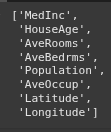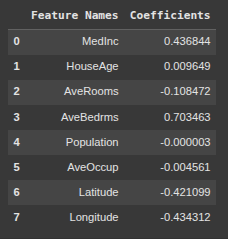Lasso Regression
#LASSO stands for Least Absolute Shrinkage and Selection Operator
#L1 regularization
#address overfitting – A model that is too complex may fit the training data very well
#but perform poorly on new, unseen data
#will get rid ofe useless features (make coefficients independent var next to 0)
#- automatic feature selection
# lead to a simpler model that is less prone to overfitting
https://www.youtube.com/watch?v=VqKq78PVO9g&ab_channel=codebasics 1:24
from sklearn.datasets import fetch_california_housing
#https://inria.github.io/scikit-learn-mooc/python_scripts/datasets_california_housing.html
ca_housing = fetch_california_housing()
X = ca_housing.data
y = ca_housing.target
ca_housing.feature_names

ca_housing.target_names
from sklearn.model_selection import train_test_split
X_train, X_test, y_train, y_test = train_test_split(X, y, test_size=0.2, random_state=19)
#Lasso regularization is sensitive to the scale of the features,
#so it’s a good practice to standardize the data to have zero mean and unit variance.
from sklearn.preprocessing import StandardScaler
scaler = StandardScaler()
X_train = scaler.fit_transform(X_train)
X_test = scaler.transform(X_test)
from sklearn.linear_model import Lasso
lasso = Lasso()
lasso.fit(X_train, y_train)

from sklearn.metrics import mean_absolute_error, mean_squared_error, r2_score
y_pred = lasso.predict(X_test)
mean_absolute_error(y_test, y_pred)
mean_squared_error(y_test, y_pred)
r2_score(y_test, y_pred)
#apply a param grid
#Alpha controls the strength of the regularization penalty
#You can fine-tune the alpha parameter to control the strength of the regularization penalty.
#Smaller values of alpha will result in less regularization,
#while larger values will increase the regularization effect and drive more coefficients to zero.
param_grid = {
'alpha' : [0.001, 0.01, 0.1, 1.0, 10.0, 100.0]
}
from sklearn.model_selection import GridSearchCV
lasso_cv = GridSearchCV(lasso, param_grid, cv=3, n_jobs=-1)
lasso_cv.fit(X_train, y_train)

y_pred = lasso_cv.predict(X_test)
mean_absolute_error(y_test, y_pred)
mean_squared_error(y_test, y_pred)
r2_score(y_test, y_pred)
lasso_cv.best_estimator_

lasso3.intercept_
lasso3.coef_
#if a coefficient was zero, then the lasso model would disregard it
import pandas as pd
feature_names = ['MedInc', 'HouseAge', 'AveRooms', 'AveBedrms', 'Population', 'AveOccup', 'Latitude', 'Longitude']
df = pd.DataFrame({'Feature Names': feature_names, 'Coefficients': lasso3.coef_})
df

Ryan is a Data Scientist at a fintech company, where he focuses on fraud prevention in underwriting and risk. Before that, he worked as a Data Analyst at a tax software company. He holds a degree in Electrical Engineering from UCF.
